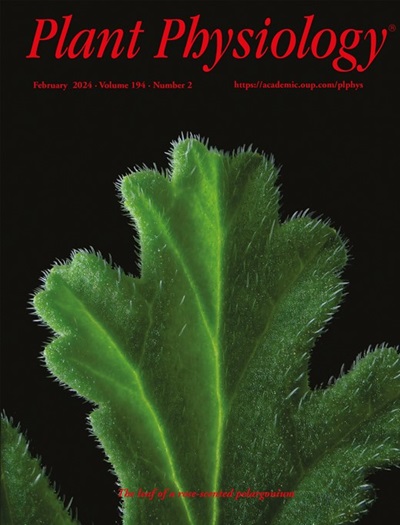Plastidial starch phosphorylase regulates maltodextrin turnover during starch granule initiation in Arabidopsis leaves
IF 6.5
1区 生物学
Q1 PLANT SCIENCES
引用次数: 0
Abstract
PLASTIDIAL STARCH PHOSPHORYLASE 1 (PHS1) is considered integral to starch synthesis, yet its role in transient starch synthesis in photosynthetic tissues remains unclear, as mutation of PHS1 in Arabidopsis (Arabidopsis thaliana) does not affect the metabolic profile of leaves. PHS1 activity is elevated in the starch branching enzyme sbe2.1 sbe2.2 double mutant, which lacks starch granules but retains intact genes encoding granule initiation proteins, making it an ideal plant material for exploring PHS1 function. We generated a triple mutant, sbe2.1 sbe2.2 phs1-1, which showed additional accumulation of soluble maltodextrins, a loss of insoluble linear α-glucans in the leaves, and substantially retarded plant growth, compared to the sbe2.1 sbe2.2 double mutant. STARCH SYNTHASE 3 (SS3) and SS4 activities increased in the sbe2.1 sbe2.2 phs1-1 triple mutant relative to the sbe2.1 sbe2.2 double mutant. Additional loss of SS4 in the sbe2.1 sbe2.2 phs1-1 background partially reversed phenotypes observed in the triple mutant: maltodextrin content decreased, insoluble α-glucans reappeared, and plant growth improved. Principal component analysis revealed that the metabolite profile of the sbe2.1 sbe2.2 ss4 and sbe2.1 sbe2.2 phs1-1 ss4 mutants, particularly the levels of organic acids from the tricarboxylic acid cycle, more closely resembled that of the wild type than that of sbe2.1 sbe2.2 and sbe2.1 sbe2.2 phs1-1. These findings suggest that PHS1 plays a critical role in maltodextrin turnover and carbon regulation in chloroplasts, maintaining a coordinated balance of synthetic and degradative activities. We propose that PHS1 functions as a metabolic buffer, with its role becoming more crucial when starch synthesis pathways are disrupted.拟南芥叶片淀粉粒形成过程中,可塑性淀粉磷酸化酶调节麦芽糖糊精的周转
PLASTIDIAL STARCH PHOSPHORYLASE 1 (PHS1)被认为是淀粉合成不可或缺的一部分,但其在光合组织中瞬时淀粉合成中的作用尚不清楚,因为拟南芥(拟南芥)中PHS1的突变并不影响叶片的代谢谱。在淀粉分支酶sbe2.1 sbe2.2双突变体中,PHS1活性升高,该突变体缺乏淀粉颗粒,但保留了编码颗粒起始蛋白的完整基因,使其成为探索PHS1功能的理想植物材料。我们产生了一个三重突变体,sbe2.1 sbe2.2 phs1-1,与sbe2.1 sbe2.2双突变体相比,sbe2.1 sbe2.2 phs1-1表现出可溶性麦芽糊精的额外积累,叶片中不溶性线性α-葡聚糖的损失,并且显著延缓了植物的生长。淀粉合酶3 (SS3)和SS4活性在sbe2.1 sbe2.2 phs1-1三突变体中比在sbe2.1 sbe2.2双突变体中增加。SS4在sbe2.1 sbe2.2 phs1-1背景下的额外损失部分逆转了在三重突变体中观察到的表型:麦芽糖糊精含量降低,不溶性α-葡聚糖重新出现,植物生长改善。主成分分析表明,突变体sbe2.1 sbe2.2 ss4和sbe2.1 sbe2.2 phs1-1 ss4代谢产物谱,特别是三羧酸循环有机酸的水平,比sbe2.1 sbe2.2和sbe2.1 sbe2.2 phs1-1更接近野生型。这些发现表明,PHS1在叶绿体中麦芽糖糊精的转化和碳调节中起关键作用,维持合成和降解活性的协调平衡。我们提出PHS1作为一种代谢缓冲,当淀粉合成途径被破坏时,它的作用变得更加重要。
本文章由计算机程序翻译,如有差异,请以英文原文为准。
求助全文
约1分钟内获得全文
求助全文
来源期刊

Plant Physiology
生物-植物科学
CiteScore
12.20
自引率
5.40%
发文量
535
审稿时长
2.3 months
期刊介绍:
Plant Physiology® is a distinguished and highly respected journal with a rich history dating back to its establishment in 1926. It stands as a leading international publication in the field of plant biology, covering a comprehensive range of topics from the molecular and structural aspects of plant life to systems biology and ecophysiology. Recognized as the most highly cited journal in plant sciences, Plant Physiology® is a testament to its commitment to excellence and the dissemination of groundbreaking research.
As the official publication of the American Society of Plant Biologists, Plant Physiology® upholds rigorous peer-review standards, ensuring that the scientific community receives the highest quality research. The journal releases 12 issues annually, providing a steady stream of new findings and insights to its readership.
 求助内容:
求助内容: 应助结果提醒方式:
应助结果提醒方式:


